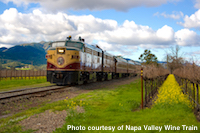One of Napa Valley's most well-known wineries is Inglenook, formerly Rubicon Estate, owned by Francis Ford Coppola. According to an article written by San Francisco Chronicle wine critic Jon Bonné, Napa Valley’s legendary winemaker Robert Mondavi visited the Coppolas at the estate and said, “You realize what this is? You have bought the most beautiful, the most important winery property in the Napa Valley.”
Why did Francis Ford Coppola believe in and fight for the Inglenook name after achieving success and recognition with Rubicon and the Niebaum-Coppola Estate winery when Inglenook had been regarded as a cheap wine since the 1960s? Coppola saw something different. It meant coming full circle by reuniting the land, the name and eventually the old Inglenook cabernet once cherished at wine auctions.
The regal estate and mansion, with a 180-degree panoramic view of the valley floor from a Napa Valley hillside, is hallowed ground as it encompasses Napa Valley’s entire wine history. A century ago, it made bottles like the 1941 cabernet, which is regarded as one of the best wines in the new world.
Finnish-born Gustave Niebaum purchased Inglenook (Scottish for cozy corner) back in 1880. Niebaum’s state-of-the-art production equipment and sanitary facilities had never before been utilized in wine mak- ing in America. Niebaum died in 1908, but Inglenook’s greatest glory came to be after the 1920-33 Prohibition era when the nephew of Niebaum’s widow, John Daniel, began running the winery, producing a noble range of wines, which included some of the finest reds ever made in Napa.
Due to tough economic times, the estate was sold in 1964 to Allied Grape Growers, which later became United Vintners; the largest wine producer in California. It cast aside organic farming for conventional pes- ticides. Five years later, spirits conglomerate Heublein acquired the winery. Inglenook’s reputation had become associated with cheap jug wines and was devastated.
In 1975, Coppola purchased the Daniel family’s Victorian mansion and vineyards and discovered a pile of 1890 Inglenook bottles in the cellar. On occasion, he would sneak down to grab one, as he did on the day Mondavi came to visit. According to Jon Bonné, Coppola recalled, “We went down. We took another bottle of the 1890. We brought it up and I opened it for him, and the perfume of it filled the room and we drank it. And it was wonderful and he started dancing around and said, ‘See, a Napa Valley wine’–and here it was in the actual cellar–‘You can make a wine as great as any in the world.’”
The inaugural vintage of Coppola’s Rubicon wine was vinified the following year and Coppola named the estate Niebaum- Coppola. Coppola purchased the remaining vineyards and Niebaum’s original chateau in 1995 and then 140 acres of the neighbor- ing Cohn ranch in 2002. In 2006, Coppola changed the property’s name to Rubicon Estate. As he felt that winemaking had become too mechanized, he returned to organic farming with simpler methods of production and assembled a team of win- emakers sharing his vision. Coppola finished making the Inglenook winery and estate whole again when he bought the Inglenook name in 2011 and was once again producing wine that would make John Daniel proud.
The estate is open daily for wine tastings and tours of the chateau and grounds. A full list of tastings and events is available on the www.inglenook.com website. tj
Napa Valley Wine Train Celebrates 150 Years of Railroad History and 25 Years as Napa Valley's Most Distinctive Restaurant

FOR a remarkable experience while enjoyung Napa Valley's gorgeous scenery, climb aboard the Napa Valley Wine Train. The luxurious three-hour round trip echoes the glory days of train travel with restored antique rail cars and a fine dining service with multi-course meal cooked to order and of course, an extensive wine list full of delicious local wines. In 2014, the Napa Valley Wine Train, whose rail line is alnost as old as the State of California, celebrated its silver anniversary. The rail line upon which the train travels was built in 1864 by San Francisco's first millionaire, Samuel Brannan. The concept of the Napa Valley Wine Train was made possible by Vincent DeDomenico (inventor of Rice-A-Roni and former owner of Ghirardelli Chocolate and Golden Grain Pasta) who bought the whole operation and set the Napa Valley Wine Train off on its inaugural passenger trip on September 16, 1989. Go to www.winetrain.com for more information. tj
The complete article can be found in Issue #276 of the Tokyo Journal. Click here to order from Amazon.


























